Cordial greetings to all the steemians. In this issue I will discuss an aspect of the religiosity of the inhabitants of the Andean region of Merida, in this case I will relate a semblance of Santa Barbara, a saint of the Catholic tradition.
Santa Barbara arrived during the colony with the faith of the Spaniards and soon was syncretized in the spiritual imaginary of the Andean population, staying forever in the hearts of the inhabitants of the new world. From ancestral times, the mountain people, faced with the duality of telluric elements and human frailty, request protection from pre-Hispanic deities and Christian saints.
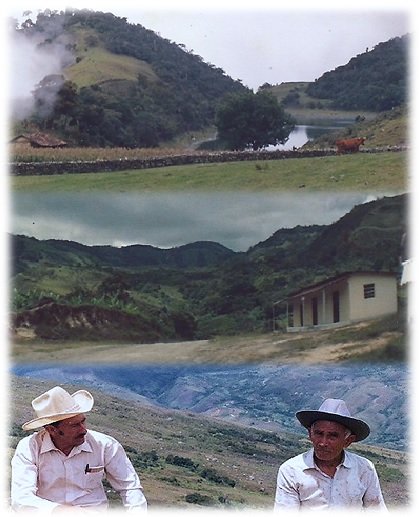
Reinaldo and Nicanor Close to Fat Stone - Aldea El Moral.
The wild environments that are experienced in the mountains of southern Mérida, allow its inhabitants the opportunity to lead a peaceful life, living a daily life that revolves around field work, family affairs and their religiosity.
Its existence is sometimes marked by the plea for divine protection, in the face of unexpected events and events, caused by natural phenomena that occur in the mountains.
Within the popular religiosity, the Andean stories allude to protective spirits that animate diverse expressions in the mountains; arch, lagoons, water eyes, rain, haze, wetlands, wind and sun.
The Andean peasant in his imagination interprets its existence in the territory through the facts, in the face of adversity calls for help to the deity through the saints of their faith, which fulfill specific relationships in their worldview, received through the orality and the indoctrination of the Catholic Church.
The locals observe and interpret these telluric phenomena, seeking the reason for their existence, and supplicate through promises to the saints, the mediation and protection of God before the imminent dangers they represent; the storms, the lightning, the hail, the landslides, the avalanches, the floods of rivers and streams with the arrival of the rains.
The numerous pictorial representations of Santa Barbara in European and Near Eastern regions verify the historical existence of this oriental martyr, venerated in the Christian churches of East and West since the fourth century, knowing chronicles about her, derived from her extensive iconography and patronages expressed through surprising narrations.
Its origin dates back to the third century after Christ. He was born in Asia Minor in Nicomedia, a place near the Black Sea. She was the only child, her mother was called Repé, who died leaving her an orphan at an early age. His father called Dioscorus was an official of the Roman Empire. Barbara stood out for her beauty and intelligence, and for Dioscurus it was her golden opportunity to increase her fortune, achieving a prosperous family alliance, espousing her with a man of wealth.
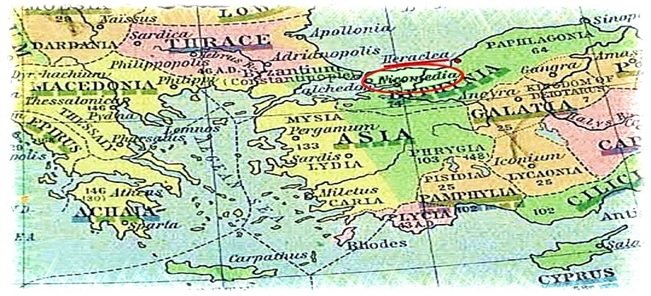
One day, an order from the Roman Emperor came to Dioscorus to carry out a military operation, which meant leaving his home for a long time. Dioscorus had a tower built with two windows and in that place he locked Barbara in to protect her from the outside world, preventing them from admiring her beauty and seducing her in his absence, as well as confinement in the tower, preventing her from approaching them, subversive ideas of Christianity very much in vogue at that time.
The tower in its interior, had the necessary comforts so that Barbara could lead a pleasant life and allow her to receive a first quality education, through famous contracted pedagogues, of them she knew the philosophical and historical thought of her time.


Know Christianity and question the pagan gods .
During her confinement in Barbara's life, two notable events occur. She knows the Christian ideas which question her beliefs in the pagan gods and Barbara decides to break with these ideas. Send a message to Origen, a Christian scholar, to initiate him into faith in Christ. Origen could not attend to his request and instead sent Valentine his disciple, he was received by Barbara and immediately began teaching about the Christian faith being baptized. The oral tradition tells that this circumstance was involved in amazing events, it is related, that two luminous beings appeared; John the Baptist and Jesus of Nazareth. John baptized her and Jesus gave her a palm and a ring after her baptism.
His decision to convert to Christianity involved a great danger for Barbara, because the Imperial Laws established violent penalties for the followers of Christian ideas, but in Barbara, she could further her faith in Christ that calmed her soul.
At that time in the absence of her father, Barbara ordered to build a third window to the two that had the tower, to symbolize the Holy Trinity.
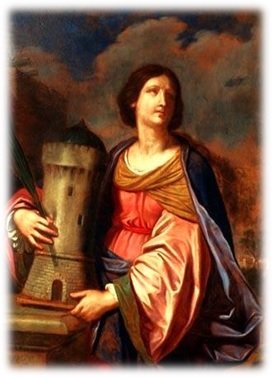
Barbara declared her Christian faith
When returning Dióscuro of the military operation by the Roman provinces, it arrived with the decision to deliver to Barbara in marriage to one of the princes who tried it, which arrived attracted by their beauty and the mystery that surrounded the maid enclosed in the tower , but she rejected those proposals of marriage, because Barbara perceived that if she agreed to the marriage proposals she would move away from her goal, Barbara thought to lead a perfect life immersed in her encounter with the true God in her heart.
Dióscuro asked the workers, why there were three windows in the tower, instead of two as he had ordered, they said that his daughter had it built. Dioscorus asked Barbara and she confessed her Christian faith, saying that she had chosen Christ as her heavenly spouse, that the three windows symbolize the light to the world and all its creatures, representing the three manifestations of God: Father, Son and Holy Spirit, in which she believes and the only one she adores.
Dioscurus became violent and warned him that if Caesar got to know he could lose everything he had accumulated in his life. But despite his attempts to get Barbara to abandon her beliefs, these were vain, there came a time when Dioscurus unleashed his fury against Barbara, drew his sword and rammed it to murder her.
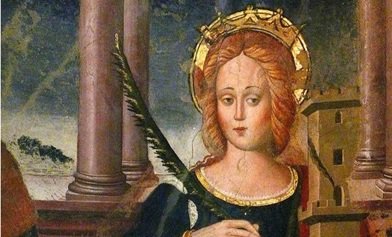
Santa Barbara surrendered to God
At that moment, Santa Barbara surrendered to God entering the realm of deity, where only extraordinary beings enter by divine help. Santa Barbara miraculously levitated through the air and flew towards some nearby mountains, some shepherds were witnesses of this prodigy when seeing it sail through the air. Barbara takes refuge in the mountains, where a cliff miraculously opened for her to enter.
Dioscorus went out in search of soldiers until they found her, she was captured so she could be judged by the Roman Justice. Dioscorus caught her by the hair and dragged her before a Praetor named Martian, who was said to be animated by the darkest evil.
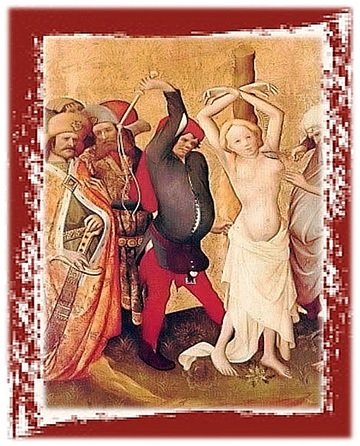
Santa Barbara received all kinds of torture
Marciano ordered that the torments begin, the executioners tied Santa Barbara on a colt, they flagellated her and dislocated her. They placed her in a bed of broken glass while her tormentors walked on her body material to cause deeper wounds.
They put her on a torture contraption called a bed of spears, made of a rectangular wood with hundreds of sharp-pointed picks, but Santa Barbara was still alive. In view of this prodigious and incredible fact, Marciano ordered that the young woman was beaten on the head with a mandrills used to demolish stone walls to cause her death, but surprisingly I endure the punishment.
But the sadism of the treacherous praetor did not come to an end, the malignant official ordered one of the executioners to cut off the breasts of the saint with a sword, and the bloody torturer of rennet tore off her breasts, but Santa Barbara was still smiling.
They raised her bleeding body to a cart that carried her down the streets of the city, showing her completely naked, the tradition tells that a new miracle occurred, under the skies an angel and a cloak covered her nakedness, while the beastly individuals whipped her and kicked
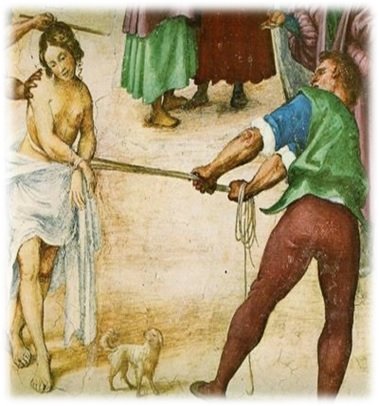
Santa Barbara only asked God for mercy for his executioners
There is no doubt that anyone who was not assisted by a superior force would have endured the tortures that were applied to Santa Barbara. The oral tradition tells that someone among those present assured that he only asked God for mercy for those who made her suffer.
When the cart that transported it, arrives with the prisoner to the central square, the legend says that there is again a divine manifestation in the form of light, as bright as a thousand suns together, which temporarily left no vision to all who observed the martyrdom of the saint.
Totally unconscious, Santa Barbara was dragged into a dark dungeon where she remained three days without water or food. Legend has it that in the dungeon Jesus of Nazareth visited him, cleaned his wounds, took care of her and fed her. Santa Barbara miraculously recovers and when the soldiers open the prison door they are surprised, instead of finding a corpse, the prisoner receives them standing and smiling, several soldiers flee in terror, their commander forces them to return and bring her before her the Martian Praetor.
Consumed the feast of blood, barbarism and hatred, Santa Barbara was questioned by Marciano, who asks him to choose between, worship the pagan gods and save his life or die. Santa Barbara answered him with a firm voice: Because of my faith in my God, creator of heaven, earth and all things, I offer myself as a sacrifice. Seeing the Pretor Romano that Barbara, despite the tortures, was full, of infinite strength, physical, mental and spiritual, she decreed the death penalty by beheading. At that moment his father Dioscoro intervened telling those present: I am his father, I do not want him to die in other hands than mine he took his sword and approached with a single blow, cut the head of his daughter.

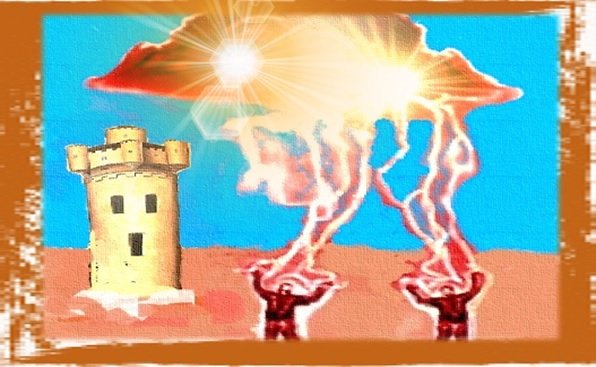
This unusual event shocked the inhabitants of the city, while growing in their hearts a wave of panic, all felt guilty for the murder of Santa Barbara, which should never have happened, but nobody did anything at the time to avoid it.
The martyrdom of the body of Santa Barbara did not end with his death, according to Roman laws his body could not receive burial, he should be thrown into the sea or left abandoned in the field to be eaten by birds of prey. Then, a Christian called Valenciano comes into action, a nobleman posing as a high official of the Roman government recovers the body and takes it to the town of Gelasio, where he received a Christian burial.
An ancient tradition points out that the last thing that Santa Barbara asked of God before dying, was that he blessed and helped all those who remembered his martyrdom, which happened in the second century of our era, in Nicomedia, Asia Minor, in the time of Emperor Maximinus the Thracian.
She is a saint of the Roman Catholic Church and the Greek Orthodox Church and her feast is celebrated on December 4th. She remained buried in Gelasio with Saint Juliana who also suffered martyrdom. Later at the end of the 9th century his remains were moved to Constantinople and deposited in a church erected in his name in that city, it was one of the most important pilgrimage centers of Christianity. The cures of the patients who came to venerate these relics were very numerous.
Santa Bárbara in his iconography is represented with blue, white, green dresses and a red cloak. In his images are present various symbols; A palm between his hands, symbol of his martyrdom for his faith. Peacock feathers, symbol of his immortality. A tower with three windows, the three manifestations of a single God. A crown with different variations, in some it is a princess, in others, the crown is formed by several towers. The sword is the symbol of your unwavering faith. A chalice with the Eucharist
means his conversion to Christianity. The energetic discharge of lightning is a symbol related to his martyrdom and his faith.
For the ray that annihilates its executioners is the Patron Saint in high-risk jobs; the miners who manipulate dynamite cartridges. The stonemasons, with explosives, destroy stones. The artillerymen of many armies, is also the patron saint of electricians and metal smelters.
Santa Barbara came in the faith of the Spanish colonizer, there are in all of America diverse populations that bear the name of Santa Barbara, various cities have her as their Patron Saint. In Venezuela, several towns are named after him. She is the Santa Patron of Guaraque, in the south of Mérida and de Rubio, in the Táchira State. The cities of Santa Bárbara de Barinas and Santa Bárbara del Zulia are named after him, near the Catatumbo Lightning of Lake Maracaibo, as well as other towns in the national geography.
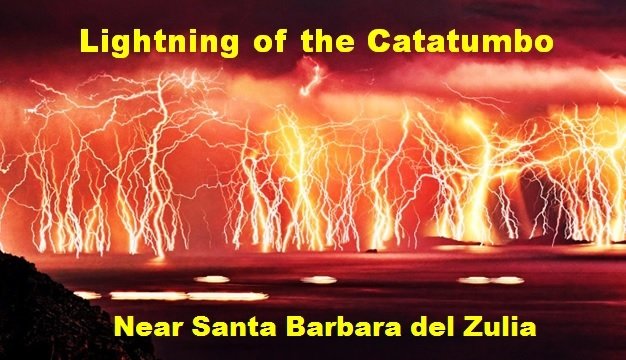
In June of 1884 Guaraque a small town in southern Mérida State was erected as an Ecclesiastical parish under the patronage of Santa Bárbara, in this town they gather during the celebration, hundreds of people come from different parts of Venezuela and Colombia to honor and venerate it in his house, the Church that bears his name in Guaraque.
From November 20 to December 6, there are held annually Fairs dedicated in his honor, within these celebrations, December 4 is the central day of his Patron Saint, devotees according to the faith they profess to attend the Mass , offer them offerings, display pyrotechnics and pay promises in gratitude for the favors granted. These festivities have great appeal, the church glorifies their devotion through masses and baptisms, the attendees express their joy and gratitude with music, dances and fireworks.
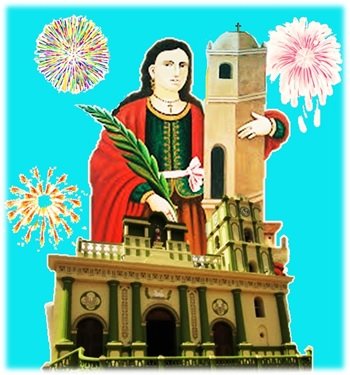
The inhabitants of this region of the Venezuelan Andes have a great devotion. There are innumerable stories about the miracles of Santa Barbara, protecting them from stormy storms and the electrical storms that occur in the region during the rainy season.
Some stories I heard from my great-grandmother Froilana Contreras who lived in the village El Moral near Guaraque, she said that when the image of Santa Barbara arrived at the Church of the People, her image was in a tiny picture, and that every year there was changing the frame because the canvas was loosened, she had blue ribbons of different sizes in a reliquary, due to the changes that had taken place on the canvas for several years. Another story told by my great-grandmother Froilana was that sometimes, during her parties it is customary to walk to Santa Bárbara through the town, there are people who invite her to their homes, but there are places where she does not want to enter and the platform becomes so heavy that they have to desist from the attempt. It is also said that on some occasions the image of the church disappeared because he was visiting another Saint in a village near Pregonero.
From the imaginary of the Andean peasant we met with prayers to ask Santa Barbara, protection against the storm and turbulence, because she calms the fierce storm and protects from the spark, the calm of the deafening thunder from his solium embroidered with stars.
"Santa Barbara, blessed virgin, great of immense power, may God be with you, and lead me on the path of good. With your winning sword, save me from evil, injustice, envy and evil eye. With the power of lightning protect me from my enemies, glorify the muzzle of my gun and allow it to emerge victorious. With the cup of your cup and the wine keep the strength of my body and spirit for the hard struggle and combat. To my fruits and flowers, receive them as an offering that I always keep in mind in my thoughts and in my home, and I beg you never to leave me and come to me every time I claim you to defend my faith, my land, my family, my fight, and that at the end of my days you take me to the glory of the Lord. Amen."
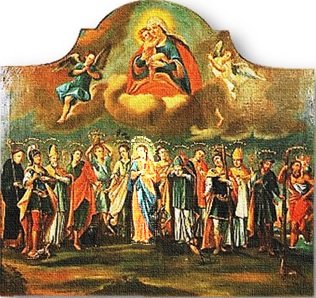
The fourteen Holy Protectors and the Virgin Mary
The Catholic Church instituted the cult of Santa Barbara placing it among the 14 protector saints, beings extolled by their faith and being particularly efficient to respond to the invocations directed by their devotees on specific problems.
Santa Barbara resolves the impossible causes and is called by believers of the Christian world. His cult is adorned with a large number of improbable, contradictory and theologically surprising elements.
Santa Bárbara is invoked requesting protection of people and their property against the ravages of the storm and the sparks of the Rays. In moments of grave social confusion, it gives protection to the innocent, it grants the liberation of the oppressed, it shows us the way to defend our principles and ideals over any oppression.
Through judgments and proverbial phrases the meteorological content is present, "remembers Santa Bárbara when it thunders". Normally it is used figuratively, evidencing a habitual behavior of human beings, who leave for tomorrow what they can do today, postponing and postponing any action.
When Santa Barbara is implored, it allows her children to hear the voice of nature and protects them from any adversity. According to popular beliefs, storms are triggered by various causes; by reason of the natural cycles, nature seeking equilibrium before the depredation caused by human beings. When the gale is very strong the bells of the churches are ringing, and the priest, by means of prayers, asks for the intermediation of the saints to calm the storm.
Fearing that lightning could affect the ammunition shells, explosive deposits are called 'Santa Barbara' in many armies and armies of the world. Santa Barbara is the patron saint of the artillery, by the analogy of the cannon boom with lightning and thunder, as well as the miners, stonemasons, electricians.
There is another legend about Santa Barbara totally different from lesser diffusion where she is a warrior. He says that Barbara's father dedicated his life to the knowledge of chemistry and the manufacture of explosives. She provided Barbara with a careful education that allowed her to participate in her research and understanding of several languages. The young woman endowed with exceptional beauty, rejected many suitors and entered the convent of Santa Perpetua. In the year 430 the region suffered an invasion of barbarous peoples. His father led the defense of the city but died in combat. Then, the besieged called Barbara from the convent, because she knew how to make the explosives and defend the population by throwing them at the invaders with catapults. After fourteen months of siege, the city capitulated, the assailants tried to take revenge on Barbara, attacking the convent to which she had returned. She, foreseeing what was going to happen, accumulated a large amount of explosives in the basement of the convent and caused a great explosion, where conquerors and losers were crushed under the rubble. Thus Barbara died, escaping with her companions from the convent to the subsequent derision and outrage by the invading hosts.
In religious syncretism, beliefs about Santa Barbara come into harmony between cultural traits of different origin. Santa Bárbara arrived with the Spaniards and attracted the attention of the indigenous inhabitants, because of its relationship with lightning and thunder. Lightning is an Andean divinity that has the capacity to transform the one who touches, it is related to the rain, the productivity of the fields and the fertility, Santa Bárbara captivated by its determination in front of the death, by its human quality like woman, giving like result an interaction in the religious imaginary of the Andean settlers and the Castilians, mixing itself with rites and ancestral beliefs.
In Venezuela Santa Barbara's relationship with Santeria is a late belief that was established in the mid-twentieth century, came from the Caribbean particularly from Cuba in a parallel between the Christian saints and Yoruba deities. Santa Bárbara identified himself with Changó, a Yoruba orisha deity, a warrior of strong temperament and personification of firmness, governor of lightning, lightning, thunder, fire, and dance.
Another analogy with Santa Barbara is related to an archetype of the major arcana, the 16th card of the Tarot 'La Torre'. Where they are observed, almost all the elements of the iconography of Santa Bárbara, like the lightning, the tower with three windows, and two characters that collapse. The Tarot originated in the sixteenth century, but its sources are lost in the beginning of time, connecting the tarot, the Kabbalah, and the Egyptian symbolism. Traditionally card 16 of the Tarot 'La Torre', is associated with the release of certainties, the fall of lovers, the punishment of arrogance, announces chaos, accidents, catastrophes and ruin. It represents the divine wrath with its devastating beam, symbolizing the punishment of those who want to climb above their possibilities, by arrogance that is linked to the biblical episode of the Tower of Babel.
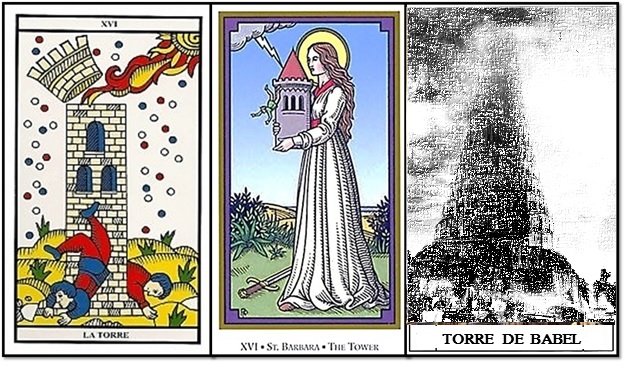
References: texts and images
http://www.larecolusademar.com/2015/12/santa-barbara-bendita_3.html
Santa Bárbara Bendita. December 4th: an evocation
https://carlossantostefano.blogspot.com/2016/12/santa-barbara-siglo-iii-patrona-de-la.html
Santa Bárbara (3rd Century) Patron of the artillery, stonemasons, miners, and of, any profession related to the handling of explosives.
https://www.tiempo.com/ram/725/meteorologia-popular-%E2%80%9Cacordarse-de-santa-barbara-cuando-truena%E2%80%9D/
Popular Meteorology: "Remembering Santa Bárbara when it thunders"
http://hablemosdereligion.com/historia-de-santa-barbara-bendita/
History of Saint Bárbara blessed: everything that is unknown to her
https://www.pinterest.es/gbrinon/barbe-ou-barbara/
Barbe ou Barbara. Pinterest
http://www.diplox.com/post-20730-santa-barbara-historia-y-pelicula.html
Saint Barbara. History and Film.
https://www.pinterest.com/pin/536702480576563661/
La Maison-Dieu XVI. The Tower (St. Barbara) - Tarot of the Saints by Robert M. Place
Infografia por : @marinomarquez